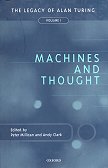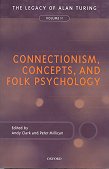Essays in commemoration of Alan Turing. This volume focuses on the Turing Test (or Imitation Game, as Turing called it); on humans as (or not as) Turing machines. The essays cover a wide range of viewpoints, and introduce many thought-provoking ideas. One or two do get rather technical for a general audience. But there's a lot to be learned here about recent advances, and recent opinions, on computability and intelligence.
Contents
- • Robert M. French. Subcognition and the limits of the Turing Test. 1996
- No machine could fool someone that it was instead a person, without having been deeply immersed in human culture. But that doesn't mean it might not be intelligent.
- • Donald Michie. Turing's Test and conscious thought. 1996
- The importance of sub-articulate and sub-cognitive thought
- • Blay Whitby. The Turing Test: AI's biggest blind alley?. 1996
- The Turing Test is not a good operational definition of intelligence, nor did Turing intend it to be
- • Ajit Narayanan. The Intentional Stance and the Imitation Game. 1996
- Daniel Dennett uses the Intentional Stance (that certain things, computers included, are best described as if they have intentions) to argue that machines can be conscious. Narayanan claims that this concept involves a circular argument, and we ought instead split it into the Representational Stance (that the computer behaves as if certain symbols in it represent certain things in the world) and the Ascriptional Stance (that explicitly treats the system as being conscious).
- • Herbert A. Simon. Machine as Mind. 1996
- A discussion of various AI programs, and the conclusion that computers already think
- • J. R. Lucas. Minds, Machines, and Gödel: a retrospect. 1996
- A reappraisal of the original 1961 paper, which argued that humans were not Turing machines, based on their being able to see the truth of a Gödel sentence. Lucas argues further along these lines, and says the only way out of this conclusion is if humans are inconsistent, a position that he does not wish to support.
- • Robin Gandy. Humans versus mechanical intelligence. 1996
- Humans can do meta-reasoning, such as recognising the truth of a Gödel sentence, because they don't just manipulate symbols, they understand what those symbols represent. There is no reason to assume a computer could not reason in the same way.
- • Anthony Galton. The Church-Turing thesis: its nature and status. 1996
- The Church-Turing thesis asserts the equality of the class of
effectively computable functions and the class of recursive
(or Turing-machine computable) functions. The latter class
is precisely defined, whereas the former is a rather vague intuitive
notion.
We thus find, in conventional computability theory, on the one hand the requirement that a computation be completed in finitely many steps, and on the other hand the lack of any constraint on the complexity of a computation. The justification for the former requirement is that infinite computations cannot actually be implemented physically; the justification for the latter non-requirement is that our theory of computation is purely abstract and hence should not be constrained by physically motivated considerations.Galton explores the Church-Turing thesis (how can two notions of such very different degrees of precision actually be equivalent?), investigates "effectively computable", and tries to sharpen the notion, whilst preventing it trivially ending up with being "Turing-computable".
- • Chris Fields. Measurement and computational description. 1996
- A physical description of computation: a series of measurements
made on a dynamical physical system are interpreted as the
computation.
The feature of computation---that simulating computing is computing---is what sets it apart from uninterpreted dynamic processes such as fluid flow. ... Searle ... fails to understand the 'systems reply' to the Chinese Room example---the claim that simulating understanding is understanding---because he misses this point.A physical system can be measured in different ways; only some can be interpreted as a meaningful computation....a single physical system can often be interpreted as different virtual machines on the basis of different sets of measurements, by interpreting the values of different sets of variables as indicative of the state of the system.Fields uses examples of measuring only input/output, in contrast to all intermediate states, to give interpretations of "higher level" computations. [This insight applies equally well to "orthogonal" measurements, such as recent work on cracking crypto algorithms using differential power analysis: looking at the power drawn by a device while it is processing.]
- • Aaron Sloman. Beyond Turing equivalence. 1996
- Intelligence isn't so much about computation, as about architecture. We need better concepts, and a higher level view. We should be examining the building blocks, the structures, how they can be put together, and how they can vary and grow.
- • Iain A. Stewart. The demise of the Turing Machine in complexity theory. 1996
- Many computational complexity classes can be characterised as classes of logical constructs. For example, NP corresponds to those problems that can be specified using existential second-order logic, and P to those that can be specified using first-order logic, successor and the least fixed point operator. Such characterisations may be more natural and useful than the Turing machine description.
- • Peter Mott. A grammar-based approach to common-sense reasoning. 1996
- Most research into reasoning has focussed on validity and expressibility. But real world reasoning needs to trade these off against speed. A syllogistic approach based on pattern matching against the grammatical structure of an utterance may be the way minds actually do some of their common-sense reasoning. (The semantics is then captured in the syllogisms and in the allowed pattern matches.) Simple pattern matching works for a large number of cases, but there are some cases where it doesn't. For example, although we can take he came in with a (box of chocolates) and infer he came in with a (box), we cannot take he came in with a (big (box of chocolates)) and infer he came in with a (big (box)). [Clearly not. Big is not the same kind of adjective as, say, red. It is a relative term: something is big only relative to a set of somethings. The two sets here, boxes of chocolates, and boxes, are different. The kind of pattern matching substitution used here is valid only if the meaning is monotonic. But this whole approach is based on a dislike for non-monotonic logics. Based on introspection, my own "common-sense reasoning" was not grammatical in this case: I found myself visualising a generic big box of chocolates, and a generic big box, "seeing" the difference, and hence realising the substitution was not valid. Maybe the reasoning step itself is based on pattern matching, but not the semantic step of selecting which matches are allowed.]
- • Joseph Ford. Chaos: Its past, its present, but mostly its future. 1996
- [I failed to understand the point the author was making in this essay.]
- • Clark Glymour. The hierarchies of knowledge and the mathematics of discovery. 1996
- Philosophers have lost interest in theories of knowledge and discovery at about the same time that a rich new mathematical basis has been developed for investigations. New work on "knowledge in the limit", and even incorporating relativism, has led to important new results.

